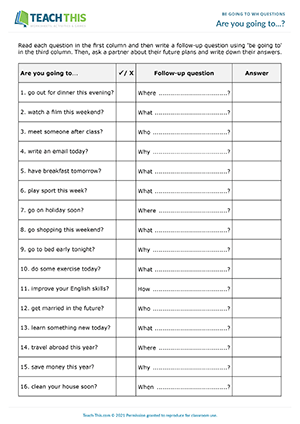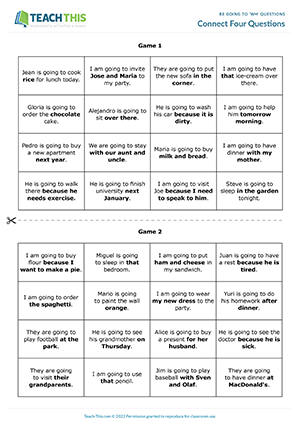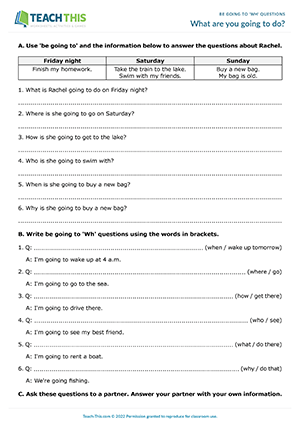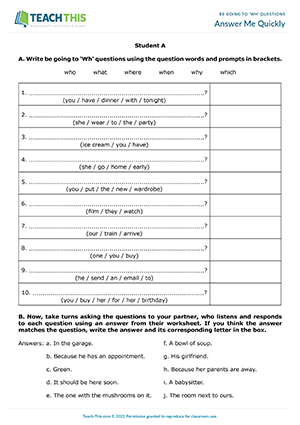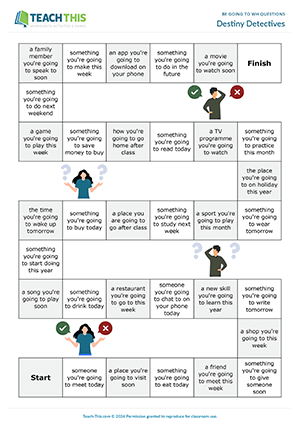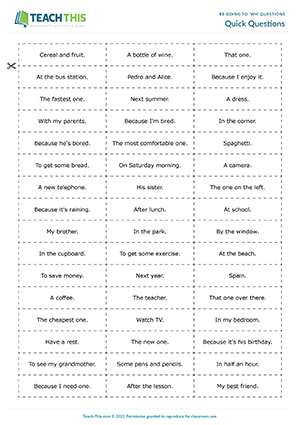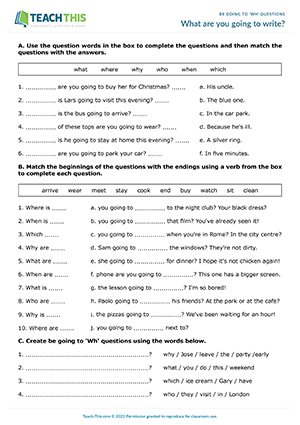In this free be going to speaking activity, students ask and answer questions about their future plans. First, students read Are you going to...? questions and write a follow-up Wh question with be going to for each one. In pairs, students then take turns asking their partner about their future plans using the questions on the worksheet. When their partner answers 'Yes, I am' to the first question, the student puts a tick and asks the follow-up question. If their partner answers 'No, I'm not', the student puts a cross and moves on to the next question. When the students have finished, they tell the class about their partner's future plans.
In this engaging be going to questions game, students play Connect 4 by forming questions from answers. Players take turns choosing a square and making a be going to Wh question from the answer in the square. For example, if the square read 'Wyan is going to eat a pie for dessert', the player would say 'What is Wyan going to eat for dessert?' The student acting as judge then checks the answer sheet. If the question matches, the player marks the square with an 'O' or 'X' accordingly. It is then the other player's turn to choose a square. The first player to get four squares in a row wins the game. Afterwards, students play a second game, giving the student who acted as judge a chance to play.
Here is a productive be going to questions worksheet to help students practice forming, asking and answering Wh questions about future plans. First, students use information in a table to answer be going to Wh questions. Next, students write be going to Wh questions using words in brackets and then ask and answer the questions with a partner. After that, students use question words from a box to write be going to Wh questions asking about underlined information. Students then complete be going to Wh questions with their own ideas and answer them. Finally, students ask their partner the questions and note down their answers.
In this fun be going to questions speaking activity, students create be going to Wh questions from prompts and then race to match them with suitable answers. First, students write ten be going to Wh questions using question words and prompts in brackets on their worksheet. Next, students work with a partner and race other pairs to be the first to match the questions with suitable answers. Students take turns asking the questions to their partner, who listens and responds to each question using an answer from their worksheet. If the student agrees their partner's answer matches the question, the student writes the answer and its corresponding letter in the box next to the question. If they don't think the answer matches, their partner tries again with another answer. When a pair has matched all the questions and answers, they put up their hands to have their answers checked. The first pair to finish wins.
In this be going to true or false board game, students practice forming be going to Wh questions and statements. Students take turns rolling the dice and moving their counter along the board. When a student lands on a square, they pick up a true or false card from the pile and look at it, without showing anyone. The student then makes a be going to statement about the topic on the square, giving either true or false information as indicated on the card, e.g. 'I'm going to meet my sister after class.' The other students then ask be going to Wh questions to determine if the student is lying or telling the truth, e.g. 'Where are you going to meet her?' After a few questions have been answered, the group members guess whether the student's answer is true or false. The student then reveals the answer. The group members who guessed correctly each score one point. The next student then rolls the dice, and so on. When a student reaches the finish, the game ends and the points are added up. The student with the most points wins the game.
In this fast-paced be going to questions game, students race to create Wh questions with be going to that elicit specific short answers. In groups, students take turns picking up a card and reading out the answer on the card, e.g. 'Cereal and fruit.' All the students then race to create a be going to Wh question that matches the answer. The first student to say a grammatically correct and appropriate question wins and keeps the card, e.g. 'What are you going to have for breakfast tomorrow?' If group members think a question is incorrect or a winning question is repeated, the student who asked the question is out of the round and the other students continue racing to come up with a question. The student with the most cards at the end of the game is the winner. As a variation, you can have students write down their questions before saying them.
This useful be going to questions worksheet helps students practice or review a variety of Wh questions with be going to. First, students use question words in a box to complete questions and then match the questions with answers. Students then match the beginnings of questions with endings using a verb from a box to complete each question. Next, students create be going to Wh questions using prompts. After that, students use verbs from a box in their be going to form and subjects in brackets to complete Wh questions. Following that, students write be going to Wh questions that match answers in bold. Students then write three be going to Wh questions to ask a partner about their plans this evening. Finally, students ask the questions to their partner, who responds with two truthful answers and one lie. The student then tries to identify the lie each time.
Latest Free
Resources
- The Bus Stop
Getting Around (B1)
Date Added: 1st of October
- Study Skills Showdown
Study Skills (B2)
Date Added: 10th of September
- Everyday Objects Bingo
Everyday Objects (A1-A2)
Date Added: 25th of August
- Action Verb Races
Actions (A1-A2)
Date Added: 18th of August
- Birthday Basics
Birthdays (A1-A2)
Date Added: 8th of August
Latest Member
Resources
- Casual Greetings
Greetings and Introductions (B2)
Date Added: 22nd of October
- Identifying and Clarifying Problems
Dealing with Problems (B2)
Date Added: 22nd of October
- What if we tried...?
Dealing with Problems (B2)
Date Added: 22nd of October
- Suitable Excuses
Making Excuses (B2)
Date Added: 21st of October
- Superlatives Showdown
Superlatives (A1-A2)
Date Added: 21st of October



